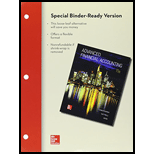
Concept explainers
a.
Sale of subsidiary sales by parent:When parent sales share of subsidiary, parent has to recognize a gain or loss on the difference between selling price and the change in the carrying amount of its investment. From consolidation viewpoint, when subsidiary reacquires its share from parent, the transaction represents an internal transfer and does not give rise to a gain or loss.
Because the gain or loss will be eliminated in consolidation process. A better approach is for the parent to adjust additional paid-in capital rather than record gain or loss on the transaction.
The consolidation entry needed to complete consolidated
b.
Sale of subsidiary sales by parent:When parent sales share of subsidiary, parent has to recognize a gain or loss on the difference between selling price and the change in the carrying amount of its investment. From consolidation viewpoint, when subsidiary reacquires its share from parent, the transaction represents an internal transfer and does not give rise to a gain or loss.
Because the gain or loss will be eliminated in consolidation process. A better approach is for the parent to adjust additional paid-in capital rather than record gain or loss on the transaction.
The preparation of consolidated balance sheet worksheet
Want to see the full answer?
Check out a sample textbook solution
Chapter 9 Solutions
LOOSE-LEAF Advanced Financial Accounting with Connect
- Can you help me solve this general accounting question using the correct accounting procedures?arrow_forwardCan you help me solve this general accounting question using valid accounting techniques?arrow_forwardI am trying to find the accurate solution to this general accounting problem with appropriate explanations.arrow_forward
- I am looking for the correct answer to this general accounting problem using valid accounting standards.arrow_forwardPlease help me solve this general accounting problem with the correct financial process.arrow_forwardPlease provide the answer to this general accounting question using the right approach.arrow_forward
- I need help with this general accounting question using standard accounting techniques.arrow_forwardmanagerial accounting questionarrow_forwardA firm is considering making a change to its capital structure to reduce its cost of capital and increase firm value. Right now, it has a capital structure that consists of 20% debt and 80% equity, based on market value. The risk-free rate is 6% and the market risk premium is 5%. Currently the company's costs of equity, which is based on the CAP<, is 12.5% and its tax rate is 40%. What would be Carwright's estimated cost of equity if it were to change its capital structure to 60% debt and 40% equity?arrow_forward

 AccountingAccountingISBN:9781337272094Author:WARREN, Carl S., Reeve, James M., Duchac, Jonathan E.Publisher:Cengage Learning,
AccountingAccountingISBN:9781337272094Author:WARREN, Carl S., Reeve, James M., Duchac, Jonathan E.Publisher:Cengage Learning, Accounting Information SystemsAccountingISBN:9781337619202Author:Hall, James A.Publisher:Cengage Learning,
Accounting Information SystemsAccountingISBN:9781337619202Author:Hall, James A.Publisher:Cengage Learning, Horngren's Cost Accounting: A Managerial Emphasis...AccountingISBN:9780134475585Author:Srikant M. Datar, Madhav V. RajanPublisher:PEARSON
Horngren's Cost Accounting: A Managerial Emphasis...AccountingISBN:9780134475585Author:Srikant M. Datar, Madhav V. RajanPublisher:PEARSON Intermediate AccountingAccountingISBN:9781259722660Author:J. David Spiceland, Mark W. Nelson, Wayne M ThomasPublisher:McGraw-Hill Education
Intermediate AccountingAccountingISBN:9781259722660Author:J. David Spiceland, Mark W. Nelson, Wayne M ThomasPublisher:McGraw-Hill Education Financial and Managerial AccountingAccountingISBN:9781259726705Author:John J Wild, Ken W. Shaw, Barbara Chiappetta Fundamental Accounting PrinciplesPublisher:McGraw-Hill Education
Financial and Managerial AccountingAccountingISBN:9781259726705Author:John J Wild, Ken W. Shaw, Barbara Chiappetta Fundamental Accounting PrinciplesPublisher:McGraw-Hill Education





